Suunto has pushed out an update today to the Suunto 9 series (Baro and non-Baro variants, plus all the colors of the rainbow) that adds in three fitness-focused features that originally premiered back on the Suunto 3 and Suunto 5 units. These three features were all from the greater collection of FirstBeat features, used by companies including both Suunto and Garmin.
In the case of these features, Suunto initially launched them on the lower end Suunto 3/5 series, but like Polar recently, they came to discover that people buying higher-end watches at 2-3x the price prefer to have all the features, versus just some of the features. Not to mention that more and more higher-end endurance sports focused watches are just as much about the daily training grind as they are about the other 22-23hrs of your life that you spend sleeping/recovery/working. So having stats to measure and monitor that is key.
In any case, the Suunto 9 gets the following new features:
Sleep Quality: This will give you a nightly score for how good your sleep was, by leveraging heart rate variability
Fitness Level: This gives you your VO2Max score as well as fitness age, after workouts are completed (and in a dashboard widget)
Stress & Recovery: This shows your body ‘resources’ (think Street Fighter Battery Level), as well as current recovery state. This is akin to Garmin’s Body Battery functionality, and both are identical from FirstBeat.
Automatic Time Zone via smartphone: Now, when connected to the Suunto App via your smartphone, it’ll automatically sync your time-zone to that of your phone. Previously you had to manually adjust that every time, which for those of us living in this decade felt awfully old-school. Thankfully, that’s no more.
Atop that, there’s two additional sets of ‘enhancements’ listed on the release notes:
Improved GPS tracking accuracy with new GPS firmware: Like Polar and Garmin, Suunto also uses the new Sony GPS chipsets that everyone else is using. In fact, Suunto was the first one to adopt them. And, like everyone else, it’s been a super-slow roll to get these Sony GPS chipsets producing accurate tracks. I think we’re largely there, and this update takes the latest from Sony and ports it into the Suunto 9. Suunto says this should fix some GPS track wobbles seen previously.
Tips for altitude added: These are some tips around understanding altitude drift, and how to use calibration or GPS to correct for that.
Tips for first usage added: These are for first time users, to help them understand how to use the watch better. This is actually kinda cool, and the first time a user starts a workout it tells them (and forces them) to wait for HR lock, and wait for GPS lock, before starting. They can quit the prompts, but it’s a cool ‘Stop effing with me’ type message that helps users get better data by just waiting a second for HR/GPS lock.
Now, for lack of anywhere else to stick it, note that while the Suunto 3 & 5 also have adaptive training programs, the Suunto 9 won’t be getting that. From talking to Suunto, they don’t see the target market of that overlapping with the Suunto 9 buyers. I’m not sure I agree, as Polar also found out (the hard way) that didn’t apply when they brought FitSpark (which is vaguely in the same category of adaptive training programs) to their similarly priced Polar Ignite, but skipped the Vantage series. This winter though FitSpark will be ported from Ignite to Vantage.
In the case of Suunto though, they may attract just a bit more hardcore enough of an audience that their thinking might actually hold true. Maybe. Or maybe not. I’m not sure. Either way, it does cost money to license that from FirstBeat, so that might simply be a factor as well.
The Features:
So let’s do a quick look at all of these, first up is Fitness Level. You’ll find this down in roughly the same area as other day to day type trending features. When you first upgrade, it’ll say that you need to do a 15-minute run or walk with GPS and heart rate in order to get a value:
So, I did that.
I went out and did a simple 5K run. Mostly long-run paces (easy), and then the last few minutes I pushed the pace into 10KM paces. At the end of it I received a VO2Max Estimate:
Of course, if you know me – you know that’s a wee bit low. But that’s pretty common in my experience for initial VO2Max estimates from companies. Most times (and this is true of FirstBeat driven data), it takes longer workouts and more of them before it gets more accurate. In other words, it learns. And undoubtedly I’d have gotten a better set of data from a 90-minute run versus a 5K run. But that isn’t in the cards on today’s schedule.
In addition to displaying this in the post-workout summary, it also now shows in your widgets down below. In fact, it shows two values here. First is the VO2Max (48.4), along with the fitness state below that (‘Excellent’).
And then if you swipe to the right you’ll see that VO2Max value again, but along with your fitness age below it. Yeah – it thinks I’m only 20 years old! Boom!
These are also then sync’d to the Suunto smartphone app as well.
Next is the stress and recovery via resources. As noted earlier, this FirstBeat function basically is how much energy you have. As you sleep, this number goes up, and as you do hard exercise or are otherwise stressed, this number goes down. Sit on a couch and watch a romantic comedy, and it’ll usually go back up again. For the most part, on other Suunto & Garmin watches that have this functionality I find it pretty good (after at least one full day to calibrate itself).
And here’s an initial look at the resources after wearing it a short period of time:
Whereas, if you had a full day’s worth of data, it’ll look like this (the last 16 hours worth):
Next, there’s the sleep quality. In order for this to work you’ll need to remember to enable sleep tracking on the Suunto 9, within the settings. Once that’s done then you’ll get sleep tracking data after a night’s worth of sleep. This sleep quality level is based on heart rate variability primarily, which is leveraging the optical HR sensor on the back of the unit. Sleep quality is then given in a metric of 0 to 100. 100’s the highest, and 0 means you have a newborn at home.
I don’t have the data yet from a night’s worth of sleep, but here’s what it’ll look like according to Suunto
Finally, as for the GPS accuracy updates – my test run puts that in the category of ‘Meh’. For this run, I had the Suunto 9 on my right wrist, the Garmin Venu on my left wrist, and then a FR935 hand-held. Overall it was blah, actually one of the worse FR935 and Suunto 9 tracks I have. The Venu had the best track of the three, but nothing to be terribly proud of. Here’s that data set.
In any case – GPS accuracy aside, it’s good to see these features arrive on the Suunto 9 – it brings them more in line with their endurance sports competitors at Garmin and Polar in terms of features. Obviously there’s more to watches than just features, such as reliability or durability, but features and by that extension accuracy, are two of the biggest drivers in this market.
With that, go forth and get your watches all updated, and start using the newness!
Thanks for reading!





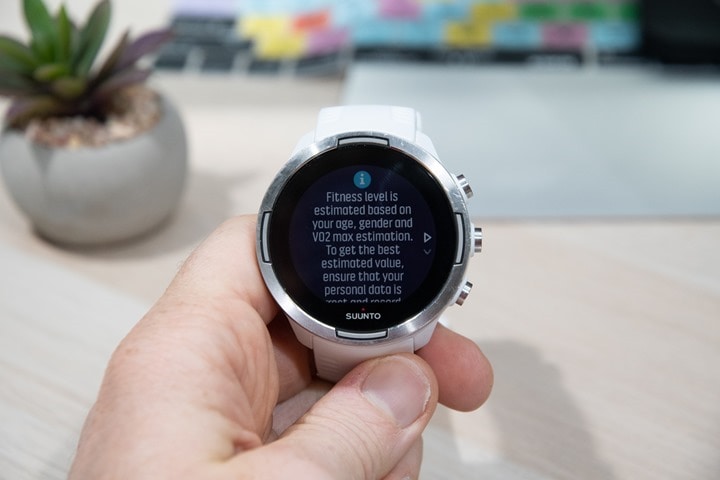
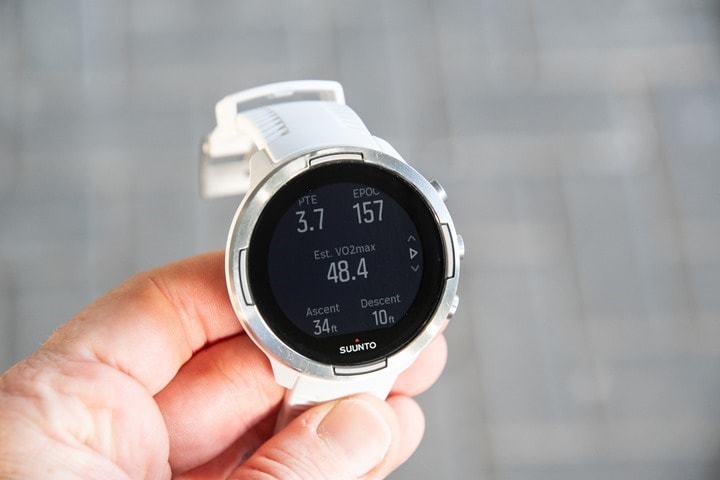
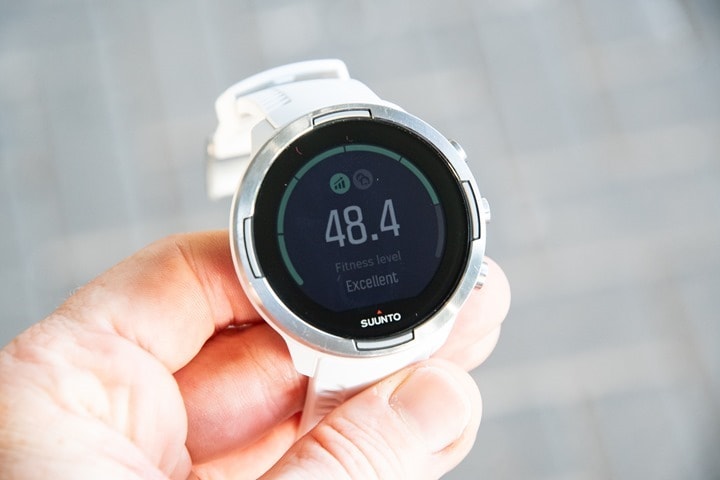
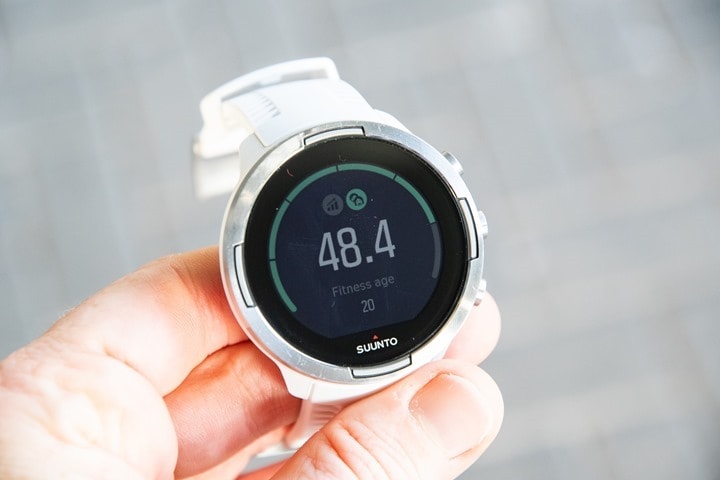


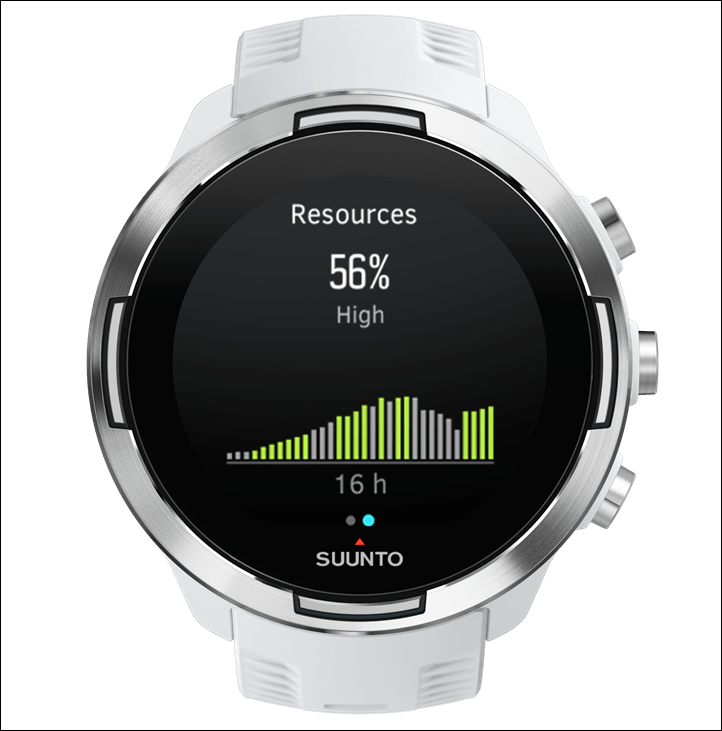

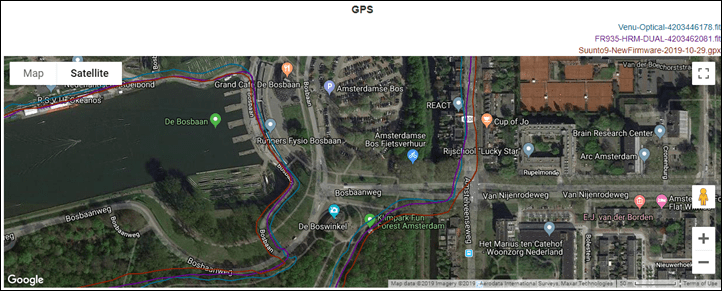
















Thanks as always. Just updated my S9 Baro and will give a test soon. Do you think the GPS updates were a step backwards, or perhaps just had a bad day? Odd that the 935 would have a simultaneous bad day as well.
My guess is more of just a random bad day. Odd, no weather at all – just a nice sunny day.
Will GPS accuracy for most current devices jump from “meh” to “wow” in 2022/2023 when GPS III becomes available to consumer devices?
Or will new chipsets and/or firmware updates be required?
I think we’ll continue to see improvements here. Some of it is also antenna design though.
I am interested to see what’s happening on the app side – I am aware there were two different apps that were used for different things. Is this still the case?
Sadly, still forked.
It’s getting better on the Suunto app side, but the website side is still horrible.
Hi Ray,
Sportracker is not Suuntos website service for their new service.
I think this has been mentioned to you quite a few times here and there.
Kr,
Dimi
It is (Sports Tracker).
Though, they’re saying they’re focused on mobile only gonna forward.
I’m not sure why you’re saying it’s not. Movescount is absolutely discontinued, but Sports Tracker is where things are headed these days for new devices.
Do you understand that Sportstracker is another company ?
If Sportstracker is Suunto’s website then Salomon is Suunto’s shoes.
I think you mistake the brands under the Amersports umbrella.
Just kindly asking you to reconsider what you say
You can’t use the Suunto App without your data being in SportsTracker. It’s the same backend database. Suunto as part of the Suunto 3 and Suunto 5 launch referred to it as ‘their platform’ (in place of Movescount).
When I e-mail back and forth with Suunto about it, they have control over that platform and it’s features. As present they aren’t actively pushing those features forward on the desktop (web) side, but they noted recently they’ll add more features if the market demands.
When the company (Suunto) talks about features it does or doesn’t have from a web standpoint, it includes SportsTracker as part of that discussion.
Finally, if we look at all of the connectivity for the Suunto App from a 3rd party standpoint, it all flows through SportsTracker. There isn’t any actual separation there.
Ray,
because one can login with the ST credentials to the Suunto database (shared databse) or even use the SportsTracker app to see their 24/7 HR from a Suunto watch that does not mean that SportsTracker is the website for Suunto. I would have been widely communicated and atm you have to really look hard to find any reference from Suunto.com or the Suunto app to SportsTracker web or SportsTracker app.
There is a feature request for a Suunto app web at Suunto’s forums as well :-)
Yes a Suunto user could use the SportsTracker web. If that is what you mean yes I agree. Why? Because they share the same database.
However, even sharing is not the same, for example link to app.suunto.com (there is no SportsTracker there).
If they wanted to guide new users there they would have to ommit any “feature request”.
Moreover the data that SportsTracker offers is a limited dataset, has it’s own zones not the Suunto users Heartrate zones or pace zones for example and so on.
From a DCRainmakers fan perspective, I would have expected not to be guided to SportsTracker web as it has 0 relation (as said before data etc) with Suunto. Its just SportsTracker web nothing more. Suunto might even come with another web.
Yeah, I’m not trying to be argumentative – but Suunto sees the Sports Tracker website as *THE* website going forward.
They’ve held two press events at CES around exactly that (that I’ve gone to). The same is true everyime I go to Finland to have in-person meetings. There is no separation there.
It’s not optional to have a Sports Tracker account. It *IS* the database for the Suunto App. It’s one and the same.
After all, if you ask how to export a file – they’ll say simply open the Sports Tracker website.
I agree the communication is wonky, but that doesn’t dismiss the historical reality of how Suunto has positioned things. They have long said that the Sports Tracker site was “choosen” as the platform going forward instead of Movescount. It was a long fought decision within Suunto, but that’s what they selected. It’s really only in the last 8-10 months that the company has said that only the Suunto App would be where they’re focusing their efforts, rather than the websites. But they spent considerable time from the Suunto 3 launch
These days, they’ve tried to whitewash most of that away. My point is that seems a peculiar omission. After all, at the launch of the Suunto 9 (some 6 months after Suunto 3) they talked specifically about you’re ‘Choice’ between using the Suunto App which had Sports Tracks behind it, or using the Movescount platform/app. With the Suunto 5 launch they almost entirely focused on the app side.
Again, until you ask to do something not in the app – in which case they tell you to use the website.
I’d agree with you if the Sports Track site was some optional thing that you manually connected. But it’s not. It’s the foundation, the core, the everything of the Suunto App. Without it, there is no Suunto App. There is no Suunto Cloud connectivity to 3rd party services, and there is no Suunto 3/5 or parts of 9 functionality. They cease to exist.
What a curious argument! If it were true that ST wasn’t Suunto then it would be immediately closed down under GDPR for holding data without consent. I’ve certainly never consented to anyone aside from Suunto collecting data from my Suunto watch other than a link to Strava.
I’m also mildy confused at someone arguing with Ray, who speaks to these sports companies every day as his job :)
That all said, it is confusing to me still after so long that there is zero marketing messaging to say ST has anything to do with Suunto. It actually looks like Suunto are shutting down Movescount in favour of a (quite crappy) third party platform from a user perspective.
Any ideas if they are pushing this out to the Spartan?
Also eager to hear about that. Anyway I guess answer is no.
Definitely want to see this on my <one year old Spartan. I waffled hard between the Spartan and the Vantage and this sort of stuff (and a lack of Myfitnesspal integration) is marring an otherwise positive ownership experience
Very unlikely. Whenever Suunto release a new series (Ambit 2 -> 3 -> Spartan -> Suunto numbers), the immediately preceding series tends to stop getting new features (and only bug fixes) very quickly. Pretty normal in the tech industry – they want to give you more reasons to spend money with them and upgrade, not less.
It’s good to see a decimal place in the VO2Max estimate. On my Garmin I can see productive, maintaining and unproductive all while on the same integer VO2Max. A decimal place would add more context to what is going on.
Do you think the GPS accuracy issue is just due to the Sony chipset ? or do you see that more as a software issue ? or a combination of both ?
I still miss my Ambit 2 as the tracks were better in my experience/opinion.
But as I have been told several times, you can’t have both long batteries and accurate tracks
I had had A2. In my opinion S9 tracks are more accurate. Yesterdays track was very good but the first track after update didnt impress (This was to be expected and unofficially communicated). We will see next moves :)
The funny thing with this Sony chip is that you need every day update the APGS data. Without this you can get really bad tracks (not always).
GPS accuracy is roughly a blend of the following:
A) GPS Chipset firmware baseline accuracy
B) Antenna Design
C) Watch company firmware decisions around things like smoothing/etc
There’s more nuanced elements too like how much power is provided, etc… but the above three are the biggies.
All of the 2019 watches from Garmin/Polar/Suunto are on the same chipset. However, take for example the Polar Ignite. By Polar’s own admission, GPS accuracy will be lesser there, which appears to stem from antenna design/restrictions. Again, same exact chipset as in their Vantage series, and likely running the exact same Polar firmware algorithms above it.
I haven’t seen any EPO/AGPS restrictions on Garmin watches in terms of daily update needs.
Interesting knowledge, thanks.
I am aware of the needed AGPS but I find that a bummer for the S9. Marketed for “explorers”, those explorers don’t always have internet connection on a daily basis. I found myself with this problem this summer when I went around MtBlanc and couldn’t sync my watch for 5 days.
I had GPS issues but not sure if it was related to AGPS.
Now, as I mentioned the Ambit 2 and Ray mentions the “antenna design”, could it be that the Ambit 2 had better tracks because of its “big sticking out” antenna while the S9 has a metallic bezel and no prominent antenna ? (I am mentioning that because the S3 has an antenna and maybe it has better tracks ?)
Agps is for helping the chip. The chip doesn’t need them per se, but they help to calculate faster.
Also Ray each company gets different fw for that Sony chip. Even models with or without antennas (s5vss9) have different GPS firmware.
So SUUNTO does not use Polars fw and for example sony added Galileo for SUUNTO and qzss a long time ago. I think s9 even laynched with qzss support.
True, they definitely get different variants of firmware. But the core of that firmware is the same codebase. It differs by versions and updates, but we’ve seen how over time the companies gain updates driven by other companies.
I find the S9 has long exceeded the A2’s GPS tracking accuracy (and frequency of logging track points). But the A3 still outperforms the S9 in my experience down here in Australia. But the A3 is also ugly as sin. :)
Hi Ray,
I know I’m wicked late to this conversation, but found it by doing research on the FirstBeat algorithm in my new Suunto Ambit3 (still not clear on that, BTW, the user manual is vague at best). But with regards to the aGPS issue, unless you have some other inside info (and please feel free to correct me) bit I don’t think sport watches use aGPS. That system is specific to cellular phone network applications. In order for a sportswatch to be able to use it, the watch _must_ have a cellular radio (phone) installed, meaning a chipset, firmware, antenna, etc. That’s a rather expensive solution to a problem that doesn’t really exist, and in many cases won’t work since you _need_ a cell tower for it to work. The reader comments above about network connectivity might be related to some other requirement specific to the device they are using, but don’t (and can’t) have anything to do with GPS. As I wrote, if you have inside info that they _are_ using a chipset that has cellular _and_ GPS connectivity, I stand corrected. Also, I have to agree with your reply to dimitrios about the firmware. With regards to GPS in a sportswatch, I can’t see the sense of having different firmware for the same GPS chipset. The output of any basic GPS chips is simply a global position with a time stamp. The chip itself will get more expensive with a more sensitive RF section, output update frequency, and the ability to acquire/track a greater number of satellites (i.e. higher sampling rate), but I’m struggling to imagine a case where any specific firmware changes would be necessary between end-user applications. Better GPS chipsets will provide information on the actual satellites it is reading data from (the NMEA data), but again, this would be completely superfluous for a sportswatch. The manufacturers don’t need or want that data, so the chips in mobile hand-held devices simply output lat-long with a timestamp. The watch firmware does the rest by storing and plotting the data. I’d be very surprised if the gps chips in watches even _allow_ firmware updates. FWIW – my experience in this area is satellite communication in the defense industry, specifically portable satcom radios for battlefield use.
I test for SUUNTO. There are gps firmware update that do improve quality due to maths and predictions.
Additionally there nmea logging if needed with all the data.
Even your a3/s9 etc logs much more than it exports to Strava , such as snr , evpe , EHPE etc.
So I don’t think you are saying it right here or I misunderstood
Have a great new year !
Does anybody have an other fitness age than 20?
Wait – so you mean I haven’t gained 17 years of Fitness Age?!?!
I’m 26 although I’m 45 :)
Pah. 20 although 52. :D
I’m in my 50s and also have a fitness age of 20 on my Suunto 3. It’s clearly wrong, as my V02max estimate has dropped from 52/53 to mid 47s over the last year or two due to getting less fit due to injury.
The “Resources” view is very, very interesting though. I’d say my performance at work is directly correlated with my resource levels. Also my watch predicted an onset of a nasty bout of flu, a warning I unfortunately ignored.
Ray — how about an interview with the Firstbeat guys? For us ancients, it is all about optimising recovery!
Oh, but you’ve missed the smallest and yet most impactful update. On exercise activity screens, they’ve added the time of day at the top. This is huge! I can’t tell you how many times someone’s asked me the time in the middle of an activity or I needed to know it due to some scheduling issue, and the only option was to pause and long press on the middle button to get to the time of day.
Such a little thing, such a big deal (at least to me.)
-Nathan-
Agreed! I noticed it as well. It is very small and on the top. Although, I was already compensating for this will a custom main screen with ‘Time of day’ in it.
There was always option to long press lower button and then time and battery status appears (without pausing the activity). I find, in fact, time appearance annoying….when working out it reminds me of my daily duties and therefore gives me a bit stress :(….but that’s me
One thing I still wish they would have added (and I hope it is to come one day!!) is that ability to unzoom/zoom in navigation without having to unlock the watch !!
Does Sleep Tracker able to track power nap? Such as 10-20 minutes power nap at lunch time?
Hi, I have a 3 year old Suunto Spartan. If I upgrade to a Suunto 9, can I pair both watches to the same phone? My Spartan is still operating smoothly, but it doesn’t have a built in-heart rate sensor. I’d still like to use both watches. Thank you.
Yes you can pair multiple watches. The app you connect to may vary depending on device, but I think the Spartan and 9 both support both apps for now.
In all honesty though you won’t tell the difference. I have the Spartan trainer and the 9 baro and they function identically. I know that sounds negative but it’s one of the real benefits of Suunto – they don’t force you to upgrade to get minor feature bumps, and they don’t try to differentiate levels the way Garmin do.
What about the barometric altimeter? Do you get similar altitude results with both watches? (Barometric VS GPS altitude?)
I’m trying to decide between spending a lot on the 9 baro or saving for other gadgets or training tools by getting the 5 instead. Coming from a trusty Ambit 2 that always performed greatly within it’s capabilities and I enjoyed it’s build quality so I expect the same from new models.
I’m also tempted by the 935 and the seemingly superior Garmin ecosystem and app but I see mixed reviews about quality issues. (Altimeters stop working and wrist HR covers cracking?)
Best regards,
Chris.
Greetings everyone,
How many days does the Suunto 9 battery last on 24/7 HR mode? Is it measuring every second like the 935 or every so many minutes ?
Regards,
Chris.
Mine lasts months between charges. It sits in a drawer in the hope that some day Suunto will get their stuff together and sort out the app integration. Of all the devices I have this is the most disapointing, and probably the only one I regret buying (and I buy a lot!). Suunto devices are in limbo right now and have been for a very long time. As a hardware device it’s quite nice, but as a training tool it’s very poor.
Thank you for your answer. Since I have been a happy Ambit 2 user for several years it would be disappointing to spend a fair amount on a new good looking Suunto and then regretting it because it’s not working as it should.
Perhaps I should wait for a new 9 or 7 or whatnot or maybe take my chances with a 935 ? (Possibly a risk because of the quality issues I mention in the above comment).
Interesting comment Dave. Care to give any detail to substantiate?
Is the 2.9.42 update a slow rollout? I connected today to update my Sunnto 9 Baro Black and it tells me it’s up to date with 2.8.28.
Yes, it was staged but as of today I’d say everyone should have if offered (I use it since a week and it’s really worth updating).
If it doesn’t pop-up, you could ask for help here:
link to forum.suunto.com
Dimitrios (the community manager) is always very helpful.
PS: somewhere in the deep of that forum there is also a description of how you can d/l the update-file and do a forced update.
It should be noted that fitness level and fitness age is not available for cycling. Seems that this has something to do with the underlying Firstbeat algorithm. Does anybody know if there is any chance that this will change?
Hi DC,
How do the extra features impact battery life? I currently own a big puke of fenix 2 and the battery is awesome as an everyday wear as well as for the training and sports.
PS been a follower of your stuff for a long long time now, excellent data and really helps people like myself cut through all the standard “this is amazing” type reviews and understand properly the benfit and negatives of the products – thank you.
I would love to see Suunto roll out a ClimbPro feature similar to Garmin’s.
As an ultrarunner that would be immensely helpful in race to see on each climb throughout the race the total elevation remaining, distance and grade on that climb
Just load in the .gpx file of your route, navigate using it, and you’ll get the vertical profile show up along with vertical feet/meters remaining on your route.
I just bought a 9 Baro and wanted to adjust the Date, but everything I tried did not work. Is there a manual option. Although a enabled the synchronize option and synchronized with Suunto App the date still is wrong. Shows Feb 3 Mittwoch (German for Wed) but correct would be Feb 3 Montag (Monday).
Update your device using a computer and suunto movelink. there was a bug in suunto watches that messed up the date. it started at new years day.
HI My suunto 9 does not show my fitness level or my VO2 max ..what could be wrong..I have done walks and exercising? Please if you can assist? Thanks
I’m posting this late in the day as this article is quite old. Thanks for the info. It’s good to see Suunto extending features to their flagship albeit older unit.
Several years ago, I was a loyal Ambit user. The 3 Sapphire was rock solid and had phenomenal battery life. But I have since switched to Garmin, and have had a Fenix 5, Tactix Charlie: as a soldier I thought this would be awesome, but it’s really a marketing gimmick. The night vision mode doesn’t work in the way intended, as my goggles couldn’t focus on the screen (too close), though it is a bit useful to have a very dim backlight. Now I use a Fenix 6 Sapphire, which has been excellent, barring the occasional crash/freeze.
However, Garmin charge an awful lot for the Fenix, and as recent events demonstrate, they are vulnerable to malicious actors. I am now looking at the Suunto 9 Baro as a more affordable training partner.
I am curious as to whether Suunto might again be a realistic alternative for a robust training device that serves double duty as a mountaineering device? Have they got over the flakiness that seemed to plague Suunto after the Ambit?
Hi Dan S.
Apart from training one of the things I love to do is high altitude trekking in the Himalayas, so I need an a altitude.
I have an ambit 3 which is superb, altitude very accurate. I then upgraded to the 9 baro about 18 months ago, unfortunately for me the altitude is just not good, not reliable. As an example one trek I did stating and finishing at the same point and the ‘9’ was 78m out by the end of the day! Also the old ambit 3 you can mix your units of measurements, for instance I like distance in miles and altitude in meters. With the 9 it’s either imperial or metric.
In the last 10 months been using the Fenix 6, very happy generally, attitude wise more accurate.
I’m 62 and very active but when doing the fitness test (walking) it came back with a fitness age of 72! Screen much better than my Ambit 3 and the new app seems to work much better.
Suunto Baro 9 is a POS for tracking sleep. Any time up for any time at all in the middle of the night will kill the sleep tracking for that sleep period !